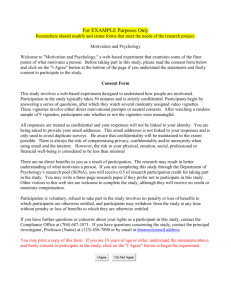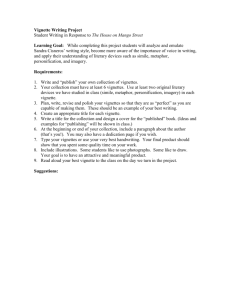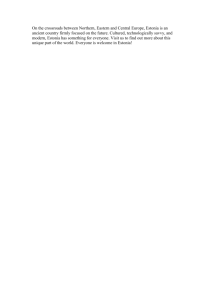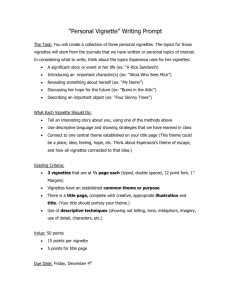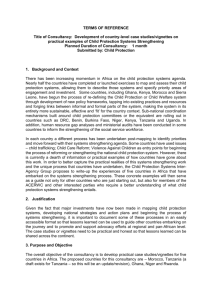PPTX - EUprimecare
advertisement
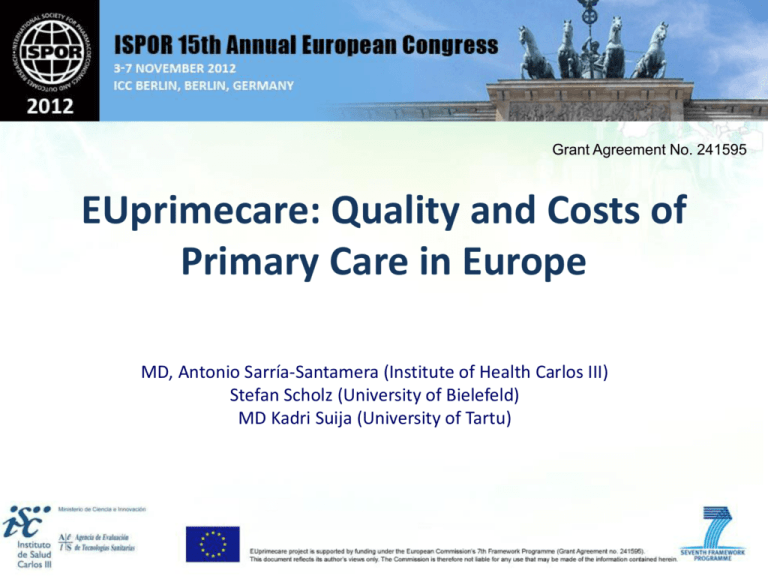
Grant Agreement No. 241595 EUprimecare: Quality and Costs of Primary Care in Europe MD, Antonio Sarría-Santamera (Institute of Health Carlos III) Stefan Scholz (University of Bielefeld) MD Kadri Suija (University of Tartu) Health Care: Iron Triangle Quality Access Costs Strong Primary Care What is Strong Primary Care? Background to describe Primary Care models in the EU is not available Not yet developed a trans-national consensus on how to define are not well identified in national accounting systems Objectives • To contribute to improving the knowledge regarding : => exploring the relationships that could exist between Quality and Costs of different models and systems of organizing and delivering PC across Europe Partners • • • • • • • • Institute of Health Carlos III. ISCIII. Spain Universität Bielefeld. UNIBI. Germany University of Tartu. UTartu. Estonia National Institute for Strategic Health Research. GYEMSZI. Hungary Országos Alapellátási Intezet. OALI. Hungary Institute for health and Welfare. THL. Finland Kaunas University of Medicine. LSMU. Lithuania Universitá Commerciale Luigi Bocconi. UB. Italy Conceptual structure WP 5 & 6 WP2 COORDINATION DISSMINATION WP 1 WP 8 REGULATION Identify a methodology to measure Quality in PC ORGANIZATIONA L BEHAVIOUR FINANCING To measure the Quality in PC ORGANIZATION OF PRIMARY CARE IN EUROPE WP 7 WP 3 & 4 ORGANIZATION PAYMENT Evaluation of PC models Identify a methodology to measure Costs in PC To measure Costs in PC Approach Evaluation of PC models in Europe Methodological Approach of a Classification System of PC Models in Europe : Germany, Spain, Estonia, Finland, Hungary, Italia and Lithuania. Methodology 1. Literature review: Structure or process of PC in Europe Control knobs: financing, regulation, payment, organization, and organizational behavior 2. Selection of => template design: Five variables (Control knobs) to optimize healthcare systems results: Range of services 3. Descriptive & Principal Component Analysis Results of Qualitative Functional modelsanalysis , Direct access to any GP or specialist (Germany) Based on a functional perspective, allowed to proposing 5 models: , Referral required from GP, mainly solopractices in PC (Hungary, Italy) 1.Direct accessfrom to specialist Referral required GP, mainly group2.Referral fromLithuania) GP, mainly solo-practices in PC practices in required PC (Estonia, 3.Referral required from GP, mainly group-practices in PC , GPs working mainly in health care centres 4.Health care centers (Finland, Spain) 5.Polyclinics , Polyclinics (Shemasko). Not necessarily GPs at all Descriptive analysis (I) FINANCING 16% Double coverage Mixed model (Hungary) 7% Uninsured BISMARCK SS (Estonia, Germany, Lithuania) BEVERIDGE NHS (Finland, Italy, Spain) 10,5% Expenditure in HC as GDP 10,6% Private Insurance 18,8% Double coverage Public contribution to HC System Expenditure in PC 6,1% 77,8% 77,2% 76,9% 24% 5,7% 6,6% Descriptive analysis (II) REGULATION • Formal mechanisms to guarantee accessibility, equity and quality of healthcare • Gate-keeping systems, except in Germany ORGANIZATION • Facilities: • Mostly public: Finland, Spain, Hungary and Lithuania • Totally private: Germany, Estonia and Italy • Clinical practice facilities: • Integrated Network: Finland and Spain • Solo & group practices: Germany, Estonia, Italy, Lithuania, Hungary Descriptive analysis (III) ORGANIZATIONAL BEHAVIOUR • Process to monitoring and improving the quality of medical practice: Quality management systems measuring clinical and no clinical quality indicators Clinical practices guidelines Continuing education Framework to define models of Primary Care Financing Provision of services through national/regional/local health systems (Yes/No) Private voluntary health insurance (Yes/No) Geographical distribution of PC services (Yes/No) Regulation Professional income (Capitation/Salary/Fee for service/Out of pocket) Payment Gatekeeping for specialist (Yes/No) Type of facilities (Public/private) Type of clinical practice (Solo practice/Group practice/ Network) Organization Organizational behavior Improvement programs & Quality management systems (Yes/No) Continuing clinical education program (Yes/No) Local adaptation of clinical practice guideline (Yes/No) Range of services Conclusions Framework for classification of health systems based on PC Multidimensional => more complex => more realistic Healthcare services financing Basic coverage Gate-keeping Private insurances Professional payment Type of facilities Type of practice Costs of Primary Care Systems Methodology Micro-costing clinical vignettes representing the main areas of activity of PC: Acute care Chronic care Health promotion Prevention (vaccination) Overall task To identify a methodology for cost measurement in primary care services and to apply it. => Challenging goal: • extreme in terms of professionals involved, payment mechanisms, services provided across countries • impossible to develop a one-fits-all method, but need to provide Chosen Method Clinical Vignettes= description of a common clinical situation, followed by a synthetic questionnaire to be submitted to professionals solve the problem of the interpretation of identical questions are a common denominator in a context of extreme heterogeneity allow to describe how a certain clinical case is managed in primary care and to estimate all the resources consumed in the delivery STEPS 1. 2. 3. 4. 5. 6. To choose the vignettes To translate the vignettes To validate the vignettes To submit the vignettes to primary care professionals To collect questionnaires To measure resources consumption in the delivery of services involved in the clinical vignettes 1. Choice of vignettes Criteria taken into account: • Main areas of primary care systems: - Disease prevention area - Care of acute but common problems - Care of chronic conditions - Health promotion services • Primary care activities/services common to all the partners of the consortium Vignettes V1: A 70-year-old man in good health comes to the practice asking to be vaccinated against the seasonal influenza V2: A 2-year-old boy comes to the practice with his mother. The day before the boy had developed cough with nasal discharge and had fever up to 38,2°C. The parent has noted a rattling sound in the child's chest. […] He has mild expiratory dyspnea. His breathing rate is 36 times per minute. […] He has atopic dermatitis but otherwise has been healthy. Vignettes V3: There is a 65-year-old woman among your patients, who has been diagnosed with type 2 diabetes. She comes in for a followup visit: the tests from last week show that her HbA1c is 7%. She has no complications. She has been taking metformin 500 mg x2. You are her main primary care provider for the next 12 months. V4: A young woman, aged 35, comes to the practice to get a certificate of “good health” for practicing a sport. She is in good health, she does sports, she has a good and satisfying job, she does not drink, nor uses drugs. But, upon you enquiring, she reveals that she has been smoking 20 cigarettes per day for the last 10 years. STEPS 1. 2. 3. 4. 5. 6. To choose the vignettes To translate the vignettes To validate the vignettes To submit the vignettes to primary care professionals To collect questionnaires To measure resources consumption in the delivery of services involved in the clinical vignettes 4. Submission of vignettes , by interviewers from each country (e.g., a group of GPs, a group of paediatricians, a group of nurses): the number of the members for each group was 20-30 and different vignettes have been submitted to the same group : professionals of each group have been requested to answer the questions related to each vignette in writing 4. Submission of vignettes In total, more than 200 professionals have been interviewed. VIGNETTES COUNTRY 1 2 3 4 Professionals Number Professionals Number Professionals Number Professionals Number HUNGARY GP 33 Paediatrician 52 GP 32 GP 29 ITALY GP 50 Paediatrician 23 GP 27 GP 50 Nurse 5 GP 39 GP 38 GP 39 GP 30 GP 30 GP 30 GP 30 Nurse 27 GP 23 GP 23 Nurse 24 GP 20 Paediatrician 21 GP 20 GP 23 Nurse 3 Nurse 3 GP 37 GP 33 GP 33 FINLAND LITHUANIA ESTONIA SPAIN GERMANY TOTAL 205 Paediatrician 23 211 206 228 STEPS 1. 2. 3. 4. 5. 6. To choose the vignettes To translate the vignettes To validate the vignettes To submit the vignettes to primary care professionals To collect questionnaires To measure resources consumption in the delivery of services involved in the clinical vignettes 6. To measure resources consumption • Data collected through questionnaires by each partner have been put together and synthesized in four different databases, specific per each vignette/questionnaire, by the Bocconi University team • This last part of the exercise had two different purposes: => to measure resources consumption in the delivery of certain primary care activities to which monetary values could be attributed; => to collect data/information useful to carry out an analysis of variation of how the same case is managed within and between countries 6. To measure resources consumption • Measuring resource consumption Methodology: Time-Driven Activity-Based-Costing = it is a particular development of the better known Activity-Based Costing (ABC) that allows to design cost models in very complex contexts, such as service organizations The TDABC requires two parameters: the time required to provide/perform the activity the unit cost of supplying capacity 6. To measure resources consumption: data collected Each vignette was structured as to gather information about: 1. medical and administrative professionals directly involved in the service; 2. the amount of time spent in the activity by the professionals involved; 3. medical material directly used in the provision of the service; 4. medical material and other health care services consumed as a consequence of the service; 5. other medical professionals involved as a consequence of the service described in the vignette. 6. To measure resources consumption: data collected Moreover, for each vignette, partner countries have provided: cost of the professionals directly involved; cost of administrative staff involved; cost of the medical material directly used; cost of the medical material and other health care services consumed as a consequence of the service; cost of other medical professionals involved as a consequence of the service; direct cost paid by patients for the provision of the service; estimation of overheads costs. SOME RESULTS FROM THE VIGNETTES V2 – A sick 2-year-old boy: Professionals involved General Paediatrician Physician Country Total cases Hungary 52 100,00% 50,00% 28,85% 30,77% Italy 23 100,00% 8,70% 21,74% 0,00% Finland 39 100,00% 66,67% 33,33% 10,26% Lithuania 30 100,00% 60,00% 10,00% 10,00% Estonia 23 100,00% 69,57% 8,70% 17,39% Spain 21 100,00% 47,62% 9,52% 0,00% Germany 23 100,00% 0,00% 86,96% 0,00% All countries 211 46,45% 28,44% 12,80% 100,00% Nurse Other PC Secretary professional V2 – A sick 2-year-old boy: Time spent in the visit Hungary Italy Finland Lithuania Estonia Spain Germany 13,9 16,3 13,8 15,7 14,7 13,4 12,7 3,3 0,7 6,3 5,3 4,0 6,2 0,0 Average time per case 2,5 0,0 0,8 0,4 0,7 0,0 0,0 Total time per case 19,8 17,0 20,9 21,4 19,3 19,6 12,7 Paediat./General Physician Average time per case Nurse Average time per case Other PC professional V2 – A sick 2-year-old boy: Time - variability within countries Hungary Italy Finland Lithuania Estonia Spain Germany Min 5 10 1 1 1 6 5 Max 30 38 30 30 20 40 30 ST.DEV. 6,64 5,92 5,82 5,97 5,48 7,70 5,90 Average time per patient 13,88 16,35 13,85 15,67 14,65 13,38 12,65 Paediat./General Physician V2 – A sick 2-year-old boy: Clinical behaviors Finland Lithuania Estonia Spain All Germany countries Hungary Italy Pharmacological Treatment 94,23% 95,65% 87,18% 76,67% 65,22% 100,00% 95,65% 88,15% Categories of drugs Fever reducer Bronchodilator Antibiotics Anti-inflammatory 24,49% 81,63% 18,37% 10,20% 54,55% 50,00% 36,36% 36,36% 5,88% 97,06% 2,94% 0,00% 26,09% 73,91% 21,74% 4,35% 0,00% 80,00% 20,00% 0,00% 23,12% 82,26% 14,52% 7,53% Hungary Italy Diagnostic tests 38,46% Specialist involved 40,38% 42,86% 85,71% 4,76% 0,00% 9,09% 100,00% 0,00% 0,00% Finland Lithuania Estonia Spain Germany All countries 30,43% 46,15% 50,00% 82,61% 0,00% 26,09% 40,28% 8,70% 64,10% 23,33% 17,39% 4,76% 0,00% 28,44% V2 – A sick 2-year-old boy: Micro-costing Hourly cost Hungary Italy Finland Lithuania Estonia Spain Germany Paediat./General Physician € 3,86 € 26,83 € 14,13 € 4,17 € 5,05 € 16,24 € 59,51 Nurse € 0,74 € 0,27 € 3,01 € 0,79 € 0,58 € 5,34 Secretary € 0,55 € 0,67 € 0,45 € 0,02 € 0,06 € 0,04 Assistant/Trainee € 0,70 € 0,61 € 0,03 € 0,09 TOTAL LABOUR COST € 5,86 € 27,78 € 18,20 € 5,01 € 5,78 € 21,62 € 59,51 DRUGS COST € 8,47 € 11,83 € 9,28 € 5,11 € 3,59 € 4,66 € 13,07 TESTS COST € 3,40 € 4,71 € 2,92 € 4,29 € 4,52 € - € 16,03 OUT-OF-POCKET € - € - TOTAL COST € 17,72 € € - - € 44,32 € - € 30,39 € - € 14,41 € - € 13,88 € € - - € 26,27 € 88,62 Methodology Macro-costing Includes • Actual costs: Real not estimated • Usual accounting principles and practices • Indicated in the estimated overall budget Personnel Costs Durable Equipment Consumables and supplies identifiable Quality of Primary Care Systems Quality dimensions, criteria, indicators QUALITY DIMENSIONS: definable, measurable and actionable attributes of the quality of care. QUALITY CRITERIA: explicit (reliable, valid and acceptable) quality requirements. QUALITY INDICATOR: variables that measure the realization of criteria. An indicator provides evidence that a certain condition exists or certain results have or have not been achieved. Edward Kelley and Jeremy Hurst: Health Care Quality Indicators Project Conceptual Framework Paper. OECD HEALTH WORKING PAPERS. 09-Mar-2006 http://www.oecd.org/dataoecd/1/34/36262514.pdf Principles for Best Practice in Clinical Audit. 2002 National Institute for Clinical Excellence. Radcliffe Medical Press Ltd Donabedian A: Explorations in Quality Assessment and Monitoring, Volume I. The Definition of Quality and Approaches to its Assessment. Ann Arbour, MI , Health Administration Press; 1980:1-164. Criteria DIMENSIONS CRITERIA Access Geographical access Access via telecommunication tools Access in time Appointment system Equity Waiting time Human resources Financial constrains Appropriateness Professional training Continuous education Competences in PHC /services Prevention services Long-term care Evidence based practice/guidelines Criteria DIMENSIONS Appropriateness CRITERIA •Usual source of care •Referral system •Continuity of care and medical information in PHC and across providers •Team-work in PHC •Clinical criteria related to preventive activities and management of chronic diseases Patient •Safety regarding medical records satisfaction/patient •Hygiene/Infection control centeredeness Professional satisfaction •Equipment (medical/non-medical) •Quality management tools (job description, audit) •Reporting system of critical incidence Methodology Quality Indicators • Focus Group Discussion : Patients (n= 53) Primary care professionals (n= 64) 7 countries: Estonia, Finland, Germany, Hungary, Italy, Lithuania, Spain. • Helped to understand the views about quality in the different partner countries and to set a list of quality criteria • Non-clinical indicators for each criteria were identified from the literature review and prioritized by scoring according to importance and measurability Methodology Quality Indicators selected to measure Quality of PC in Europe Methodology Quality at the Population Level A sample of 3.020 persons 25-75 years old 7 countries participating in the project Domains: Socio-demographic Prevention and health promotion interventions Utilization of services Self-perceived health Satisfaction Methodology Quality at the Clinical Level Diabetes and high blood pressure 9 indicators Specific approach for extracting data in each country (sample) Clinical quality indicators DM2 •Screened for HbA1c/12 months HbA1c < 7% •Screened for total cholesterol level/12 months •Total cholesterol < than 4,5 mmol/l BP < 130/80 mmHg •Eye examination (fundus photography or ophthalmologist consultation recorded)/12 months Clinical quality indicators HBP • % Patients < 140/90 mmHg • % Patients with total cholesterol screened within a year Targets of the clinical indicators in each country INDICATOR Estonia Lithuania Finland Hungary Germany Italy ≤ 140/90 ≤140/90 ≤ 140/85 ≤140/90 NA NA ≤130/85 ≤130/80 <130/80 ≤130/80 <140/90 ≤ 130/80 BP for HBP BP for DM2 Targets of the clinical indicators in each country INDICATOR ESTONIA LITHUANIA FINLAND HUNGARY GERMANY ITALY BP for both, DM2 + HBP ≤130/85 ≤130/80 <130/80 ≤130/80 NA NA Chol level for DM2 + statin treatment >4.5 >4.8 >4.5 >4.5 NA NA HbA1c level for insulin ≥8.5 ≥8.5 ≥7.0 ≥7.0 >8.5 6.57.0?
